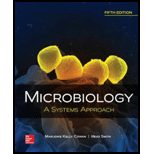
Microbiology: A Systems Approach
5th Edition
ISBN: 9781259706615
Author: Marjorie Kelly Cowan Professor
Publisher: McGraw-Hill Education
expand_more
expand_more
format_list_bulleted
Question
Chapter 20, Problem 1VC
(a)
Summary Introduction
To determine:
Whether the change on the wall of the vessel will help the organism to spread to other locations.
Concept introduction:
White blood cells or leukocytes are formed as same as RBCs by a process called erythropoiesis. White blood cells are agranulocytes or granulocytes and lack hemoglobin. They are defensive cells which provide protection against the pathogen.
(b)
Summary Introduction
To explain:
The progress of the disease in the case when organisms are able to survive phagocytosis.
Concept introduction:
White blood cells or Leucocytes have no pigment so; it is called White blood cells. It has property to defend the body against invading pathogens. They engulf the pathogens by phagocytosis and export them out of the body.
Expert Solution & Answer
Want to see the full answer?
Check out a sample textbook solution
Students have asked these similar questions
What is behavioral adapt
22. Which of the following mutant proteins is expected to have a dominant negative effect when over-
expressed in normal cells?
a. mutant PI3-kinase that lacks the SH2 domain but retains the kinase function
b. mutant Grb2 protein that cannot bind to RTK
c. mutant RTK that lacks the extracellular domain
d. mutant PDK that has the PH domain but lost the kinase function
e. all of the above
What is the label ?
Chapter 20 Solutions
Microbiology: A Systems Approach
Ch. 20.1 - Describe the important anatomical features of the...Ch. 20.1 - List the natural defenses present in the...Ch. 20.2 - Prob. 3AYPCh. 20.3 - Prob. 4AYPCh. 20.3 - Prob. 5AYPCh. 20.3 - Prob. 6AYPCh. 20.3 - Prob. 7AYPCh. 20.3 - Prob. 8AYPCh. 20.3 - Prob. 9AYPCh. 20.3 - Identify the five or six most relevant facts about...
Ch. 20.3 - Prob. 11AYPCh. 20.3 - Prob. 12AYPCh. 20.3 - Prob. 13AYPCh. 20 - Prob. 1MCQCh. 20 - Prob. 2MCQCh. 20 - Prob. 3MCQCh. 20 - Rabbit fever is caused by a. Yersinia pestis. b....Ch. 20 - Prob. 5MCQCh. 20 - Prob. 6MCQCh. 20 - Prob. 7MCQCh. 20 - Prob. 8MCQCh. 20 - Prob. 9MCQCh. 20 - Prob. 10MCQCh. 20 - Brucellosis can be transmitted to humans by...Ch. 20 - Prob. 12TFCh. 20 - Prob. 13TFCh. 20 - Prob. 14TFCh. 20 - Prob. 15TFCh. 20 - Explain why cases of dengue fever have been...Ch. 20 - Prob. 2CTQCh. 20 - Prob. 3CTQCh. 20 - Prob. 4CTQCh. 20 - Prob. 5CTQCh. 20 - Prob. 1VCCh. 20 - Prob. 1CM
Knowledge Booster
Learn more about
Need a deep-dive on the concept behind this application? Look no further. Learn more about this topic, biology and related others by exploring similar questions and additional content below.Similar questions
- Can you described the image? Can you explain the question as well their answer and how to get to an answer to an problem like this?arrow_forwardglg 112 mid unit assignment Identifying melting processesarrow_forwardGive only the mode of inheritance consistent with all three pedigrees and only two reasons that support this, nothing more, (it shouldn't take too long)arrow_forward
- Oarrow_forwardDescribe the principle of homeostasis.arrow_forwardExplain how the hormones of the glands listed below travel around the body to target organs and tissues : Pituitary gland Hypothalamus Thyroid Parathyroid Adrenal Pineal Pancreas(islets of langerhans) Gonads (testes and ovaries) Placentaarrow_forward
- What are the functions of the hormones produced in the glands listed below: Pituitary gland Hypothalamus Thyroid Parathyroid Adrenal Pineal Pancreas(islets of langerhans) Gonads (testes and ovaries) Placentaarrow_forwardDescribe the hormones produced in the glands listed below: Pituitary gland Hypothalamus Thyroid Parathyroid Adrenal Pineal Pancreas(islets of langerhans) Gonads (testes and ovaries) Placentaarrow_forwardPlease help me calculate drug dosage from the following information: Patient weight: 35 pounds, so 15.9 kilograms (got this by dividing 35 pounds by 2.2 kilograms) Drug dose: 0.05mg/kg Drug concentration: 2mg/mLarrow_forward
- A 25-year-old woman presents to the emergency department with a 2-day history of fever, chills, severe headache, and confusion. She recently returned from a trip to sub-Saharan Africa, where she did not take malaria prophylaxis. On examination, she is febrile (39.8°C/103.6°F) and hypotensive. Laboratory studies reveal hemoglobin of 8.0 g/dL, platelet count of 50,000/μL, and evidence of hemoglobinuria. A peripheral blood smear shows ring forms and banana-shaped gametocytes. Which of the following Plasmodium species is most likely responsible for her severe symptoms? A. Plasmodium vivax B. Plasmodium ovale C. Plasmodium malariae D. Plasmodium falciparumarrow_forwardStandard Concentration (caffeine) mg/L Absorbance Reading 10 0.322 20 0.697 40 1.535 60 2.520 80 3.100arrow_forwardPlease draw in the missing answer, thank youarrow_forward
arrow_back_ios
SEE MORE QUESTIONS
arrow_forward_ios
Recommended textbooks for you
 Human Biology (MindTap Course List)BiologyISBN:9781305112100Author:Cecie Starr, Beverly McMillanPublisher:Cengage Learning
Human Biology (MindTap Course List)BiologyISBN:9781305112100Author:Cecie Starr, Beverly McMillanPublisher:Cengage Learning Human Heredity: Principles and Issues (MindTap Co...BiologyISBN:9781305251052Author:Michael CummingsPublisher:Cengage Learning
Human Heredity: Principles and Issues (MindTap Co...BiologyISBN:9781305251052Author:Michael CummingsPublisher:Cengage Learning Human Physiology: From Cells to Systems (MindTap ...BiologyISBN:9781285866932Author:Lauralee SherwoodPublisher:Cengage Learning
Human Physiology: From Cells to Systems (MindTap ...BiologyISBN:9781285866932Author:Lauralee SherwoodPublisher:Cengage Learning

Human Biology (MindTap Course List)
Biology
ISBN:9781305112100
Author:Cecie Starr, Beverly McMillan
Publisher:Cengage Learning


Human Heredity: Principles and Issues (MindTap Co...
Biology
ISBN:9781305251052
Author:Michael Cummings
Publisher:Cengage Learning


Human Physiology: From Cells to Systems (MindTap ...
Biology
ISBN:9781285866932
Author:Lauralee Sherwood
Publisher:Cengage Learning

Infection Prevention and Control; Author: thecityoftoronto;https://www.youtube.com/watch?v=jx9sRYmBW3Q;License: Standard Youtube License